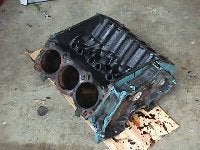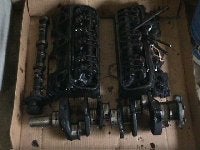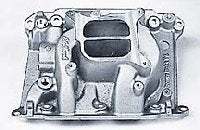Well it's hard to believe that this whole engine swap actually started out as a simple cam swap which turned into a head gasket replacement session, then it stepped up to swapping a 20R head/intake onto my 86 22R block with a set of 81-84 dome top pistons and now all the way to a full blown engine swap. If you'd have asked me a year ago if I'd be swapping a V6 engine into my truck, I'd have called you crazy!? But after adding up all the costs and comparing performance gains of the 22R modifications I wanted to perform, I simply could not justify spending that much money for the end result I expected to get. So, I chose to swap in a V6. Even the smallest domestic V6, in stock form, has more useable low rpm torque and horsepower than most "built" 4cyl. engines. While a 22R can be modified to produce an impressive amount of horsepower, it is generally well out of the useable, low rpm range for my use. Another factor to consider is long-term reliability. Whenever an engine is highly modified, you've potentially compromised reliability in the name of performance. A V6 can simply make more power in stock form and remain very reliable. I chose the Buick V6 because it is a very common engine, which is evidenced by the price that I paid for the two rebuildable cores that I bought. The 3.8L Buick V6 is a smaller engine, physically, compared to the 4.3L GM V6, but only sacrificing 31 cubic engines. The 4.3L has 262 ci. compared to the 3.8L at 231 ci. The physical difference between these two engines allow the Buick V6 to fit into the small, Toyota engine compartment a little easier than the 4.3L V6, with only a small sacrifice in power over a compartively built 4.3L V6. The Buick V6 also has the distributor in the front of the engine which avoids one problem associated with a 4.3L swap due to it having its distributor in the rear of the engine which can cause firewall clearance problems. Many will also tell you of vibration problems associated with the Buick V6. Most all of this vibration is due to the engine being externally balanced like the GM Small Block 400. Having the engine balanced at a skilled machine shop should cure most all of these vibrations and consequently cause the engine to last much longer. According to a computer simulated dyno program that I have, the engine that I have built puts out 270 ft. lbs of torque @ 2000 rpm and 175 hp. @ 3500 rpm. From these numbers you can tell that I haven't built a racing engine but a torque motor. Had I chosen a different cam I could have had much higher horsepower numbers but that isn't what a rock crawling motor needs. In fact, the cam that I selected is the smallest cam that I could find. Because of it's design and rpm characteristics at highway speeds, it will be well within its torque power range and consequently give excellent fuel mileage. For those who want to build a real 3.8L torque monster engine, stroker cranks are available from a company called Speed-O-Motive. They have cranks that have almost (0.25") 1/4" more stroke than the factory crank which would produce alot more torque. Out of the two core engines that I bought, I am currently using the '84 block, crank, and rods with a set of heads off of the '82 block because the '84 block was missing one of its heads. Any model rear-wheel drive Buick 3.8L V6 or 86-88 front wheel drive (FWD) 3.8L V6 will work in the Toyota truck. The 86-88 FWD engines have mounts for rear wheel drive use also, as well as the luxury of Sequential Fuel Injection (SFI) and tubular exhaust manifolds (though they would have to be slightly modified for rear wheel drive use). The Turbo Regal Web Site has an excellent history of the Buick V6 that contains block, crank and head casting numbers along with their production years. The Turbo V6's have the strongest crank due to it having rolled fillets. According to information obtained from the Buick Grand National mailing list, the heads with casting number: '25518445', have the best flow characteristics for a set of stock heads and the block with casting number: '25526109' is one of the strongest blocks. The 4.1L Buick V6 is also of the same family as the 3.8L V6 and is physically the same size as the 3.8L. The 4.1L has the same 3.4" stroke as the 3.8L but has a 3.965" bore as compared to the 3.800" bore of the 3.8L. The 4.1L engine shares the same crank with the 3.8L Turbo V6 engines as it also has rolled fillets making it very strong. Many report cooling problems with the 4.1L engine due to it having siamesed cylinders much like the GM 400 small block engine. I've also read reports of blocks cracking due to lower end problems with the 4.1L engine. Though I have read and heard of many using the 4.1L engine and having no problems from it. The 3.0L FWD engines also share heads on many production years. Casting numbers need to be checked carefully though. Some of the 3.0L engines also have an ECM controlled HEI distributor that will work on the 3.8L with GM TBI instead of the distributorless coil packs that the 3.8L SFI engines use. Actually, the entire 86-88 SFI intake from the FWD cars can be bolted to the earlier 3.8L RWD engines. The 3800 engine family should be avoided because this engine series no longer retains the necessary rear wheel drive transmission bolt pattern. There are a few transmission options available when using a Buick V6 several of which are the Toyota 4cyl. manual 5 speed, Toyota 6cyl. manual 5 speed, New Venture 4500, Buick bolt-pattern Turbo Hydromatic 350, GM bolt-pattern Turbo Hydromatic 350 & the GM 700R-4. The GM automatic transmissions (TH350 & 700R-4) can be bolted to the Buick motor by using an adapter plate available from Kenne-Belle Buick, Advanced Adapters, or Downey Off-Road. Anyway, here's what it has evolved into and a partial list of the parts that I'm using: |
| Part | Cost |
| 82 & 84 Buick 3.8L V6 Engines | $100.00 |
| Engine Rebuild (Machine Shop Labor) (Bore block .030 over, hone block, turn crank .010 over, remove/install cam bearings, check & recon. rods, surface flywheel, R&R pistons, and balance entire reciprocating assembly) | $400.00 |
| Machine Shop Labor for reworking heads (3 angle valve job) | $111.00 |
| Engine Rebuild (Basic Parts) | $350.00 |
| Crower Compu-Pro Mileage Cam | $119.00 |
| Needle bearing camshaft thrust bearing | $15.00 |
| Melling True Roller Timing Chain | $50.00 |
| Pistons | $80.00 |
| Advanced Adapters Headers | $105.00 |
| Edelbrock Performer Intake manifold (see photo below) | $172.00 |
| Holley 4-barrel to TBI adapter plate (Holley Part# 17-45) | $43.00 |
| 4.3L GM TBI unit | $???.?? |
| TBI wiring harness | $???.?? |
| ECM | $65.00 |
| ECM Calibration PROM | $???.?? |
| Electric fuel pump | $??.?? |
| 1995 Toyota V6 5spd. Manual Transmission | $300.00 |
| 3.8L Buick V6 -to- Toyota V6 Tranny bellhousing | $370.00 |
| Toyota V6 5spd. -to- Toyota 4 Cyl. Transfer Case Adapter | $250.00 |
| Buick 160 tooth flywheel | $50.00 |
| 10.5" High diaphragm GM pressure plate | $85.00 |
| Long GM throwout bearing | $40.00 |
| 10.5" Clutch disk with a 1-1/8" shaft - 21 spline center | $115.00 |
| Toyota Landcruiser clutch slave cylinder | $26.00 |
| Radiator (3-row) | $170.00 |
| Fan (size??) | $??.?? |
| Fan Shroud | $??.?? |
| Spark Plug Wires | $??.?? |
| Drive Shaft Modifications | $??.?? |
| Belts, hoses, plugs, dist. cap, fluids, paint, etc. | $??.?? |
| Miscellaneous | |
| Aluminum valve covers | $20 |
| 3.8L ECM Controlled HEI Distributor | $20 |
| Total Cost | $????.?? |






 Your Privacy Choices
Your Privacy Choices